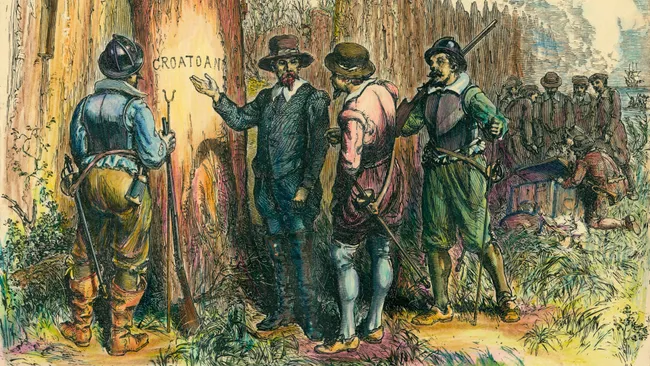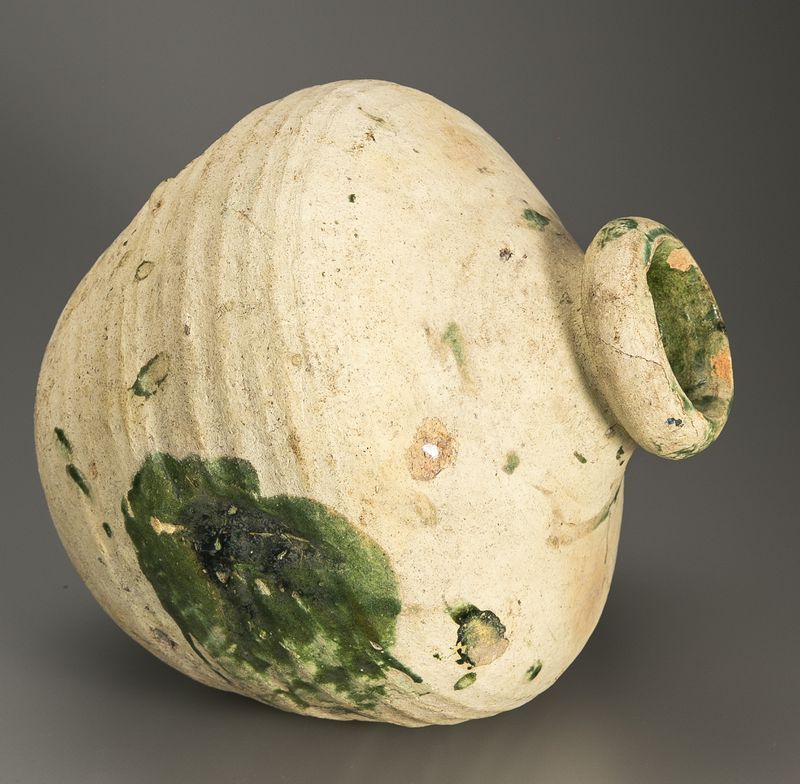In 1587, a group of English pioneers arrived in modern day Roanoke, Virginia to establish a settlement in the “New World.” After some time, resources ran low for the settlers. Fearful of an unsuccessful expedition, Sir Walter Raleigh, the statesman of the settlement, organized “…another expedition…” to regain supplies and allow “…women and children…to make the voyage” (“The Lost Colony”). The settlement split for approximately three years, sending some men back to Great Britain, and leaving the remaining men behind in Roanoke. After three years, the voyagers returned with women, children and supplies. However, to their shock, Roanoke island was unoccupied. The 115 men, women, and children had vanished for no discernible reason. Upon investigation, Raleigh’s crew discovered “…two clues to their [the missing settlers] whereabouts: the word “Croatoan” carved on a prominent post and “Cro” etched into a tree” (Lawler).Historians have speculated the reason for the disappearance of the settlers ever since.

Similar to many unresolved mysteries such as the building of the pyramids and Stonehenge, the disappearance of Roanoke led to a catalog of improbable explanations. In fact, the popular television show American Horror Story has an entire season dedicated to a Roanoke conspiracy theory, revolving around supernatural intervention.
Despite the many fanciful explanations for the disappearance of the settlers, the more commonly accepted academic explanation laid in the etchings on the posts and trees. Croatoan was the name of a Native American tribe found in modern day North Carolina and Virginia, which led historians to conclude a negative relationship between the Native Americans and settlers may have contributed to the disappearance. In fact, TheLostColony.com, Roanoke Island’s tourist website, claims “…Croatoan Amerindians accuse[d] the Roanoke Amerindians of killing the 15 men left…” by the settlers, which at first glance, suggests a conflict sparked between the groups, leading to the settler’s disappearance. However, even this theory is debatable, since it relies heavily on circumstantial evidence directed towards the Croatoan, and lacks the support of archaeological records
The mystery remained unsolved until 2015, when archaeological remains “…suggest(ed) at least some of the abandoned colonists may have survived, possibly splitting into two camps that made their homes with Native Americans” (Lawler). Additionally, archaeologists discovered “…a sword hilt, broken English bowls, and a fragment of a slate writing tablet still inscribed with a letter…” 50 miles southeast of Roanoke (Lawler). The findings suggested the settlers struggled to survive the winter months in the newly established colony, and merged with native tribes as a result.

Ironically, archaeological findings contradict nearly every aspect of previous theories, which regarded the relationship between the tribes and settlers as violent and combative. Roanoke is a case study for the importance of archaeology in modern society. Prior to the discovery of archaeological remains, historians held a harmful, false interpretation of Roanoke’s past. As a result, some likely negatively viewed the Native American tribes near the Island. If not for these findings, Roanoke’s past would remain unsettled, and therefore open to other mendacious interpretations.
References:
Lawler, Andrew. “We Finally Have Clues to How the Lost Roanoke Colony Vanished.” Culture, 7 Aug. 2015, www.nationalgeographic.com/culture/article/150807-lost-colony-roanoke-hatteras-outer-banks-archaeology.
“The Lost Colony.” The Lost Colony, www.thelostcolony.org/#:~:text=In%201587%2C%20117%20English%20men.
Photos:
Figure 1. Jarus, Owen. “What Happened to the “Vanished” Colonists at Roanoke?” Livescience.com, 20 Nov. 2021, www.livescience.com/vanished-colonists-at-roanoke.
Figure 2. Cascone, Sarah. “Archaeologists May Have Finally Solved the Mystery of the Disappearance of Roanoke’s Lost Colony.” Artnet News, 6 Nov. 2020, news.artnet.com/art-world/archaeologists-mystery-lost-roanoke-lost-colony-1921594.
Additional Information:
Video of conspiracy theories – https://www.youtube.com/watch?v=UDdt_ZHGcUA
More clues about the “Lost Colony” – https://www.cnn.com/videos/us/2012/05/07/dnt-nc-lost-colony-clue.wral

You mentioned that “the mystery remained unsolved until 2015” — what were some challenges archaeologists faced when attempting to decipher the enigma of Roanoke? How did they manage to overcome these issues?
Roanoke’s biggest archaeological challenge revolved around the lack of clues to eliminate theories. The settlement only became well-known because of its disappearance, therefore context was removed. Archaeologists had to venture away from Roanoke and into nearby settlements to discover context. Only then were they able to discover the truth.